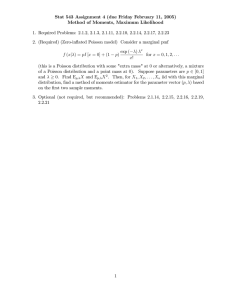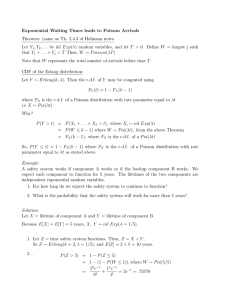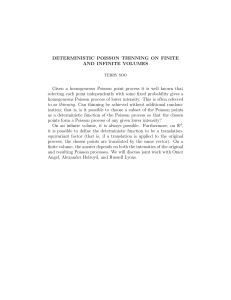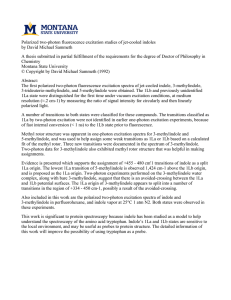Poisson Random Measures A construction of Poisson random measures
advertisement
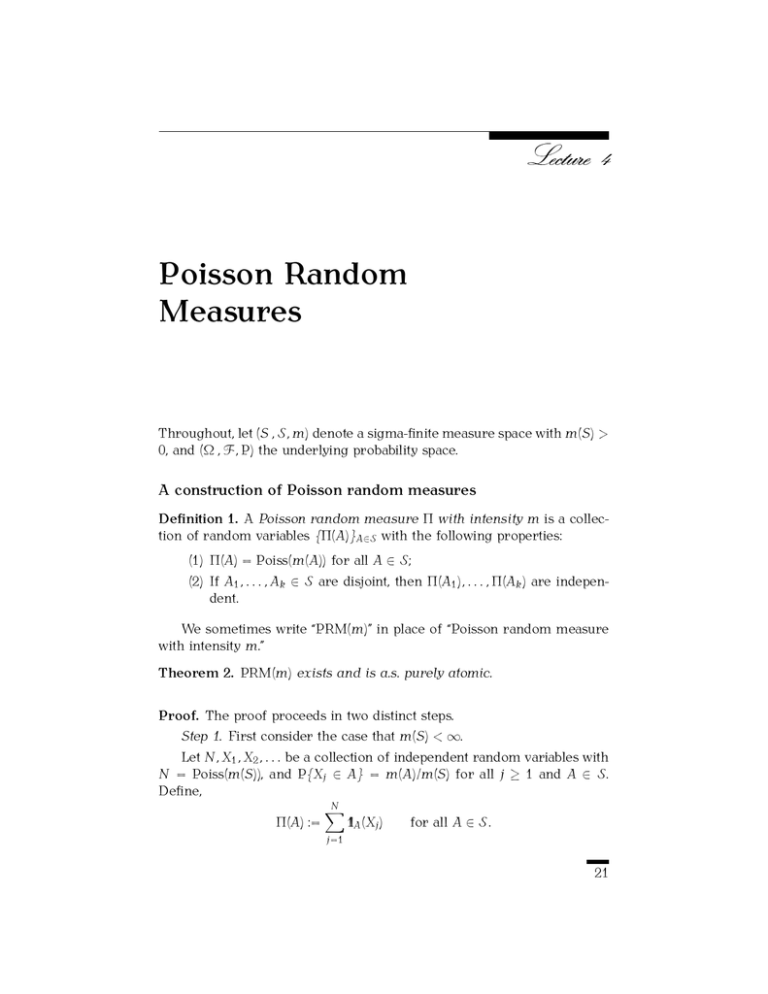
Poisson Random
Measures
Throughout, let (S � �� �) denote a sigma-finite measure space with �(S) >
0, and (٠� �� P) the underlying probability space.
A construction of Poisson random measures
Definition 1. A Poisson random measure Π with intensity � is a collection of random variables {Π(A)}A∈� with the following properties:
(1) Π(A) = Poiss(�(A)) for all A ∈ �;
(2) If A1 � � � � � A� ∈ � are disjoint, then Π(A1 )� � � � � Π(A� ) are independent.
We sometimes write “PRM(�)” in place of “Poisson random measure
with intensity �.”
Theorem 2. PRM(�) exists and is a.s. purely atomic.
Proof. The proof proceeds in two distinct steps.
Step 1. First consider the case that �(S) < ∞.
Let N� X1 � X2 � � � � be a collection of independent random variables with
N = Poiss(�(S)), and P{X� ∈ A} = �(A)/�(S) for all � ≥ 1 and A ∈ �.
Define,
N
�
Π(A) :=
1lA (X� )
for all A ∈ ��
�=1
21
22
4. Poisson Random Measures
Clearly, Π is almost surely a purely-atomic measure with a random number
[i.e., N] atoms. Next we compute the finite-dimensional distributions of Π.
If we condition first on N, then we find that for every disjoint A1 � � � � � A� ∈
� and ξ1 � � � � � ξ� ∈ R,
N
�
�
��
�
Ee� �=1 ξ� Π(A� ) = E exp �
ξ� 1lA� (X� )
�=1
�=1
N
�
�
= E E exp �
ξ� 1lA� (X1 ) �
�=1
Because the A� ’s are disjoint, the indicator function of (A1 ∪ · · · ∪ A� )� is
�
equal to 1 − ��=1 1lA� , and hence
�
�
�
�
�
�
exp �
ξ� 1lA� (�) =
1lA� (�)e�ξ� + 1 −
1lA� (�)
�=1
�=1
=1+
Consequently,
and hence,
�
�
�=1
�=1
�
�
1lA� (�) e�ξ� − 1
for all � ∈ S�
�
�
�
�
�
�(A� ) � �ξ�
E exp �
ξ� 1lA� (X1 ) = 1 +
e −1 �
�(S)
E exp �
�=1
�
�
�=1
�=1
N
�
�
� �(A� ) �
ξ� Π(A� ) = E 1 +
e�ξ� − 1
�
�(S)
�=1
Now it is easy to check that if � ∈ R, then E(� N ) = exp{−�(S)(1 − �)}.
Therefore,
�
�
�
�
�ξ
�
− ��=1 �(A� ) 1−e �
�
(1)
E exp �
ξ� Π(A� ) = e
�=1
This proves the result, in the case that �(S) < ∞, thanks to the uniqueness
of Fourier transforms.
Step 2. In the general case we can find disjoint sets S1 � S2 � � � � ∈ �
such that S = ∪∞
�=1 S� and �(S� ) < ∞ for all � ≥ 1. We can construct
independent PRM’s Π1 � Π2 � � � � as in the preceding,�where Π� is defined
solely based on subsets of S� . Then, define Π(A) := ∞
�=1 Π� (A ∩ S� ) for all
A construction of Poisson random measures
23
A ∈ �. Because a sum of independent Poisson random variables has a
Poisson law, it follows that Π = PRM(�).
�
Theorem 3. Let Π� := PRM(�), and suppose � :� S → R� is measurable and satisfies R� ��(�)� �(d�) < ∞. Then, R� � dΠ is finite a.s.,
�
�
E R� � dΠ = � d�, and for every ξ ∈ R� ,
�
�ξ· � dΠ
Ee
� � �
�
�
�ξ·�(�)
= exp −
1−e
�(d�) �
(2)
The preceding �holds also if � is a finite measure, and � is measurable.
If, in addition, R� ��(�)�2 �(d�) < ∞, then also
���
�
E �
�
R�
� dΠ −
�
R
�2 �
�
�
�−1
�
� d�� ≤ 2
�
R�
��(�)�2 �(d�)�
Proof. By a monotone-class
argument it suffices to prove the theorem in
�
the case that � = ��=1 �� 1lA� , where �1 � � � � � �� ∈ R� and A1 � � � � � A� ∈ �
�
are
�� disjoint with �(A� ) < ∞ for all � = 1� � � � � �. In this case, � dΠ =
�=1 �� Π(A� ) is a finite weighted sum of independent Poisson random variables, where the weights are �-dimensional
vectors �1 � � � � � �� . The formula
�
for the characteristic
function
of
�
dΠ
follows
readily from (1). And the
�
mean of � dРis elementary. Finally, if �� denotes the �th coordinate of
�, then
Var
�
�
� dΠ =
�
�
�=1
��2 VarΠ(A� )
=
�
�
�=1
��2 �(A� )
=
�
|�� (�)|2 �(d�)�
(3)
The L2 computation follows from adding the preceding over � = 1� � � � � �,
using the basic fact that for all random [and also nonrandom] mean-zero
variables Z1 � � � � � Z� ∈ L2 (P),
|Z1 + · · · + Z� |2 ≤ 2�−1
�
�
�=1
|Z� |2 �
(4)
�
�
Take expectations to find that Var ��=1 Z� ≤ 2�−1 ��=1 Var(Z� ). We can
�
apply this in (3) with Z� := �� dРto finish.
�
24
The Poisson process on the line
4. Poisson Random Measures
In the context of the present chapter let S := R+ , � := �(R+ ), and consider
the intensity �(A) := λ|A| for all A ∈ �(R+ ), where | · · · | denotes the onedimensional Lebesgue measure on (R+ � �(R+ )), and λ > 0 is a fixed finite
constant. If Π denotes the corresponding PRM(�), then we can define
N� := Π((0 � �])
for all � ≥ 0�
That is, N is the cumulative distribution function of the random measure
Π. It follows immediately from Theorem 2 that:
(1) N0 = 0 a.s., and N has i.i.d. increments; and
(2) N�+� − N� = Poiss(λ�) for all �� � ≥ 0.
That is, N is a classical Poisson process with intensity parameter λ in the
same sense as in Math. 5040.
Problems for Lecture 4
Throughout let N denote a Poisson process with intensity λ ∈ (0 � ∞).
1. Check that N is cadlag and prove the following:
(1) N� − λ� and (N� − λ�)2 − λ� define mean-zero cadlag martingales;
(2) (The strong law of large numbers) lim�→∞ N� /� = λ a.s.
2. Let τ0 := 0 and then define iteratively for all � ≥ 1,
Prove that {τ� −
τ� := inf {� > τ�−1 : N� > N�− } �
τ�−1 }∞
�=1
is an i.i.d. sequence of Exp(λ) random variables.
3. Let τ� be defined as in the previous problem. Prove that Nτ� − Nτ� − = 1 a.s.
